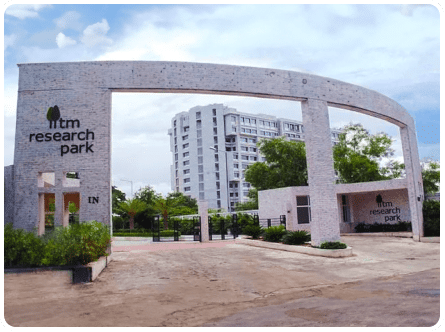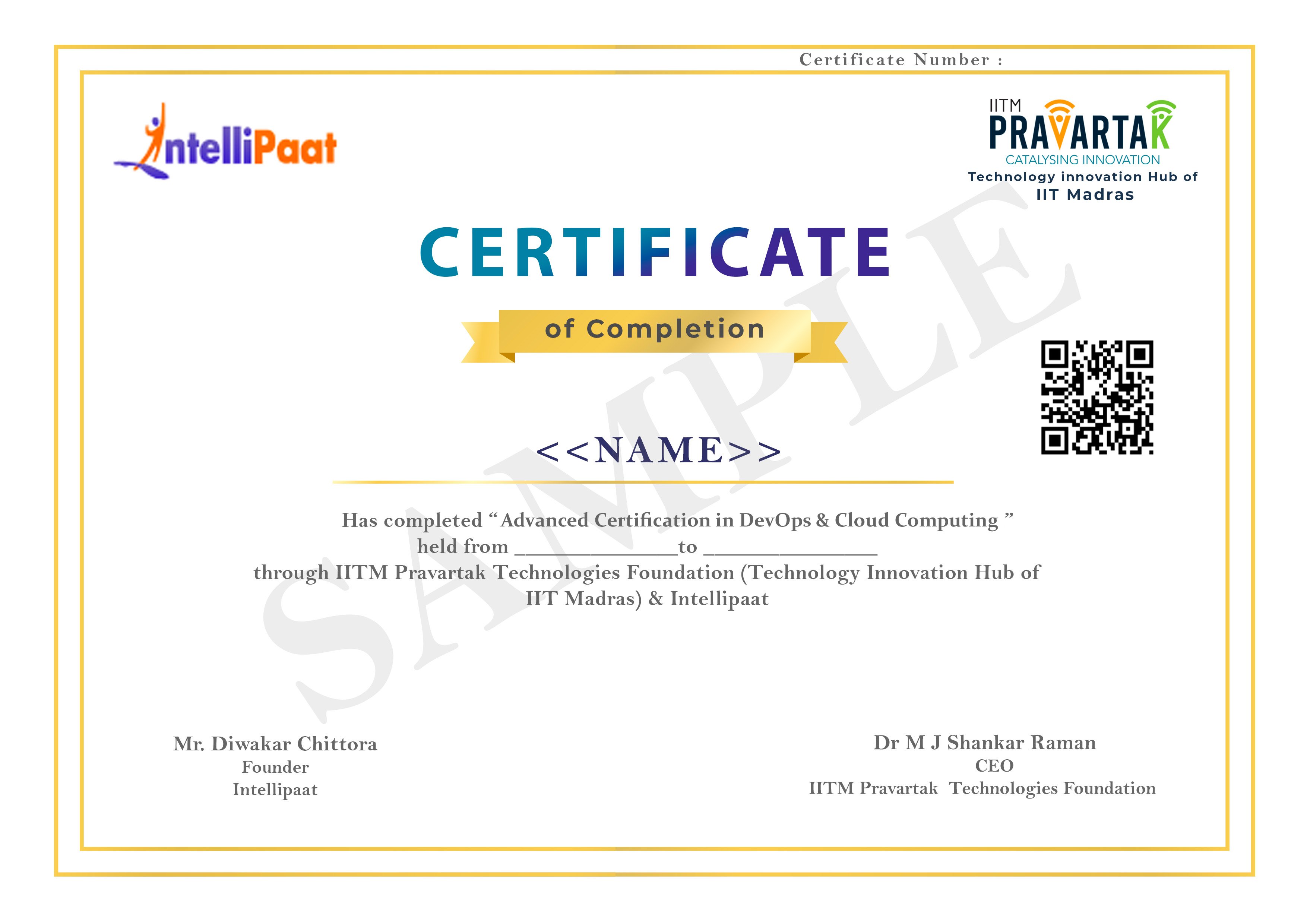Your cart is currently empty.
Enroll in this advanced certification by IITM Pravartak (The Technology Innovation Hub of IIT Madras) and Intellipaat and learn under the expert guidance of the IIT Madras faculty & Industry experts. The program is designed by industry experts to help you master AWS, cloud computing, VPC, etc., through real-time hands-on projects.

Watch
Course PreviewLearning Format
Online Bootcamp
Live Classes
6 Months
Campus Immersion
at IITM Pravartak
IITM Pravartak
Certification
EMI Starts
at ₹5900/month*
This advanced certification in DevOps and Cloud Computing by IITM Pravartak will help you gain expertise in DevOps, AWS, parallel and distributed computing, and more. The course will place extra emphasis on Kubernetes through specialized electives.
About IITM Pravartak
IITM Pravartak, a Technology Innovation Hub of IIT Madras is funded by Department of Science and Technology, GOI under its National Mission on Interdisciplinary Cyber-Physical Systems (NM-ICPS), focuses on application-oriented research and innovation in the areas SNACS. BharOS, India’s first mobile operating system is developed by an IITM Pravartak incubated company.
They are experts in using VPC, Lambda, Route 53, AWS ECS, Elastic Load Balancing, and other tools and technologies of AWS.
They design and build documents for setting the best standards and practices for cloud adoption.
They plan project deliverables and ensure the quality of products and their respective criteria as per the user requirements.
They are responsible for recording aspects of IaC using a wide range of tools like AWS CDK, Terraform, and CloudFormation.
They are in charge of the overall development pipeline, overall release schedules, individual releases, and coordination with different teams.
They are from the operations side of DevOps and are an expert in organization and management.
Skills to Master
AWS
Elastic Compute
Load Balancing, Autoscaling and DNS
VPC
CloudFormation
Access Management and Monitoring Services
AWS Migration
Version Control with Git
Continuous Integration
Continuous Monitoring using ELK
Data Virtualization
Devops on AWS
DevSecOps
Application Deployment
Tools to Master
Python
Linux
Hands-on Exercise –
Hands-on Exercise –
Hands-on Exercise –
Hands-on Exercise –
Hands-on Exercise –
Hands-on Exercise –
Hands-on Exercise –
Parallel Computing:
Distributed Computing:
One month of project work will be a part of your certification to consolidate your learning in DevOps and cloud computing. These projects will ensure that you have industry-relevant experience in the field.
Practice 20+ Essential Tools
Designed by Industry Experts
Get Real-world Experience

Admission Details
The application process consists of three simple steps. An offer of admission will be made to selected candidates based on the feedback from the interview panel. The selected candidates will be notified over email and phone, and they can block their seats through the payment of the admission fee.
Submit Application
Tell us a bit about yourself and why you want to join this program
Application Review
An admission panel will shortlist candidates based on their application
Admission
Selected candidates will be notified within 1–2 weeks
Total Admission Fee
EMI Starts at
We partnered with financing companies to provide very competitive finance options at 0% interest rate
Financing Partners
![]()
Admissions close once the required number of students is enrolled for the upcoming cohort. Apply early to secure your seat.
| Date | Time | Batch Type | |
|---|---|---|---|
| Program Induction | 22nd Feb 2026 | 08:00 PM IST | Weekend (Sat-Sun) |
After completing this program in Advanced Certification in DevOps and Cloud Computing as well as the various projects and assignments, you will receive a joint Advanced Certification from IITM Pravartak and Intellipaat.
Intellipaat provides career services that include guaranteed interviews for all the learners enrolled in this course. IITM Pravartak is not responsible for the career services.
This Advanced Certification in DevOps and Cloud Computing is conducted by the faculty at IITM and other industry experts who will train you in the area of cloud computing and advanced DevOps skills through online video lectures and real-time industry-relevant projects.
The program is designed to help you gain in-depth knowledge in this field. On the successful completion of the program, you will gain an Advanced Certification in DevOps and Cloud Computing from IITM Pravartak and Intellipaat. This certification is widely recognized by top organizations around the world and will qualify you for top-paying jobs in the market.
If you miss any of the live sessions, you will get a copy of the recorded session within the next 12 hours. If you have any other queries, you can post them in our community or get in touch with our course advisors.
There will be an optional two-day campus immersion module at IITM Pravartak during which the learners will visit the campus and learn from the faculty as well as get the opportunity to interact with their peers. However, this is subject to the COVID-19 situation and the guidelines provided by the institute. The cost of travel and accommodation will have to be borne by the learners.
Please note that the course fees is non-refundable and we will be at every step with you for your upskilling and professional growth needs.
Due to any reason you want to defer the batch or restart the classes in a new batch then you need to send the batch defer request on [email protected] and only 1 time batch defer request is allowed without any additional cost.
Learners can request batch deferral to any of the cohorts starting in the next 3-6 months from the start date of the initial batch in which the student was originally enrolled for. Batch deferral requests are accepted only once but you should not have completed more than 20% of the program. If you want to defer the batch 2nd time then you need to pay batch defer fees which is equal to 10% of the total course fees paid for the program + Taxes.
Intellipaat provides career services for all the learners enrolled in this course. IITM Pravartak is not responsible for career services. Intellipaat career services for this program contain resume building and review of LinkedIn profile.
Yes, Intellipaat certification is highly recognized in the industry. Our alumni work in more than 10,000 corporations and startups, which is a testament that our programs are industry-aligned and well-recognized. Additionally, the Intellipaat program is in partnership with the National Skill Development Corporation (NSDC), which further validates its credibility. Learners will get an NSDC certificate along with Intellipaat certificate for the programs they enroll in.
What is included in this course?
 Click to Zoom
Click to Zoom










